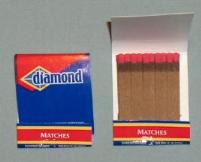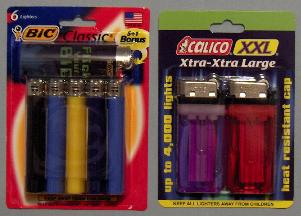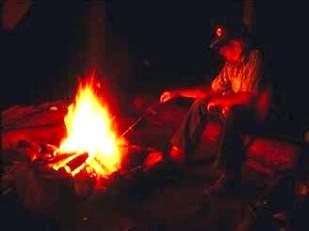
















How to Start a Fire
Using a Match or a Butane Lighter
Copyright © February 24, 2010 by Robert Wayne Atkins, P.E.
All Rights Reserved.
Introduction
There are a variety of different ways to start a fire, including both modern and primitive methods. Modern methods include matches and butane lighters. I strongly recommend that you purchase some matches and at least one butane lighter. Do not use your matches or your new butane lighter. Instead you should save them for a future emergency.
The reason I recommend matches and a butane lighter is simple. During freezing weather the striking wheel on a butane lighter can freeze and render the lighter useless for starting a fire. In that situation the matches usually work just fine. However, during really damp humid weather it is possible that the matches may get a little damp and they may become difficult to strike. In that situation the butane lighter works just fine. If you have a different backup method for starting a fire then you will have a much better chance of starting a fire under a variety of adverse weather conditions.
Paper Matches in a Matchbook

- At the present time you can buy a box of 50 matchbooks (20 matches per matchbook or 1000 paper matches per box) for about $2.00 per box. This works out to approximately 5 matches for a penny.
- Or you could follow the advice on some survival forums and you could try to learn how to start a fire using some primitive method, such as rubbing two sticks together. After one or two hours of hard labor your arms will be aching and you will probably still not have a fire going. And when you think about the fact that you could have purchased 5 matches for a penny then you will begin to wonder why you have invested one hour of your time in this unproductive activity.
- One box of 1,000 matches would yield one fire per day for approximately 3 years.
- If you practice tearing the match in half from its bottom to its top being very careful when you tear through the match head then you could light two fires per match. This is something you could easily practice right now when there is absolutely no pressure on whether or not you succeed, and whether or not you ruin a few paper matches as you learn this simple skill. But if someday you can't buy matches then you could get about 2,000 fires started using your box of 1,000 paper matches, or approximately one fire per day for about 5.5 years. (Note: On a scale of 1 to 10, with 1 being extremely easy to learn and 10 being very difficult to learn, the effort required to learn how to tear one match in half and get two fires started from a single match would be a 1 or a 2, in my opinion.)
- It is also possible to carefully split the half match again by cutting it in half with scissors up through the center of the paper and then through the center of the match head. This is easier to do if you first cut 1/2 way through the match head with a knife before you try cutting through the match head with the scissors. When you are finished each original match would now be in four pieces. This would yield 4,000 fires per box of matches or one fire per day for about 11 years. And your total investment would still only be about $2. (Note: On a scale of 1 to 10 this would rate a 2 or a 3, in my opinion. Since the one-quarter piece of match will be extremely thin it will burn very quickly and you must have your tinder material ready so you can immediately ignite it before the tiny piece of match burns out, and before it quickly burns down to your finger tips.)

Butane Lighters
Butane lighters are relatively cheap and I suggest that you consider purchasing at least two different name brand lighters made by two different companies.
A standard size butane lighter will start somewhere between 2,000 to 3,000 fires.
During a hard times tragedy event you can get the maximum number of fires started from one butane lighter if you will follow this simple procedure:
- Select something that will catch fire very quickly such as a small piece of old newspaper or a small piece of one page torn from an old phone book.
- Ignite your butane lighter and quickly put the flame below the small piece of old newspaper to get it burning. The instant the newspaper bursts into flames turn off the butane lighter.
- Immediately put the piece of burning newspaper under your tinder material to start the fire burning.
How to Start a Fire Using a Match or a Butane Lighter

- Select a safe place to build a fire that is out of the wind.
- Before you try to light a fire, begin by collecting a lot of very tiny thin dry twigs and sticks, and some small dry sticks, and some average size dry sticks. Put all of these twigs and sticks close to the location where you intend to build your future fire. Arrange the sticks into three different piles based on the size of the sticks. Dead tree branches caught in shrubs or bushes and that are off the ground are excellent fire starting material. Sticks and branches that have been lying on the ground may be used after the fire is burning well.
- Collect some high quality dry tinder. The pile of tinder should be about the size of your closed fist but very loosely arranged so lots of air can get into the stack. If possible, have at least two different types of tinder materials mixed together inside your initial tinder pile. Some examples of good dry tinder would be:
- thin strips of paper, or
- clothes dryer lint, or
- very thin strips of old dry cloth with frayed edges, or
- thin bark shavings off a dry stick (the bark and wood shavings should be the size of a toothpick), or
- very dry decayed wood that has been separated and fluffed up.
Place your tinder material on the ground where you wish to build your fire.
- Arrange some very tiny thin dry twigs above your tinder material.
- When your match or butane lighter is activated you can immediately put the fire to the tinder and start the tinder burning below the very tiny twigs or sticks.
- After the small twigs or sticks start burning you should quickly add some slighter bigger sticks to the fire.
- As the fire begins to increase in size gradually add slightly larger dry sticks. The size of the sticks should be proportional to the size of the fire. In the beginning when the fire is very small use very thin sticks. As the fire gradually gets a little bigger use slightly bigger sticks. When the fire gets to be a normal size then you may add normal size sticks. Do not smother the fire by adding sticks that are too large for the fire in its initial stages of development.
- This does not require much practice but you need to be careful or you could smother the fire and it will go out, or you could burn yourself.
How Your Ancestors Restarted a Fire without a Match or a Butane Lighter
- Use a long stick to move the ashes around inside your fireplace. Look for a glowing coal. Use your stick to move the red hot coal to an area where you can easily get to it.
- Loosely surround the glowing coal with some really good very dry tinder material, such as clothes dryer lint, or shredded newspaper, or extremely dry decayed finely crumbled wood particles.
- Blow on the glowing coal to provide extra oxygen and the tinder material should burst into flames.
- Immediately add some very tiny sticks to your burning tinder material and then gradually build the fire the way you normally would.
Footnote about Starting a Fire in the 1800s
In the 1800s families heated their homes with a fireplace and they cooked their meals using the fireplace. When they got up each morning their first chore of the day was to get a fresh fire started in the fireplace if it had gone out during the night.
If the fire was completely dead and there were no glowing coals then they would use a match to start a new fire. But matches cost money and many families could not afford them.
Therefore if the fire was completely out and they did not have a match then one of the children would pick up a "coal bucket" and walk two or three miles to the nearest neighbor's house and borrow some red hot coals from the neighbor's wood burning fire. Then the child would return home and someone would start a fresh fire using the live coals in the coal bucket. It was called a "coal bucket" because it could hold the red hot coals from a wood burning fire. (It could also be used to hold the "black coal" from a coal mine.)
These people were not stupid. In fact, they knew more about hard times survival than any "expert" today because the people in the 1800s lived in what people today would call "hard times" from the day they were born until the day they died. They also knew all the "primitive" ways to build a fire such as rubbing two sticks together. But they also knew from personal experience how much work was involved in those primitive fire starting methods. Since they had a lot of chores to do every day that required hard physical labor, it was considered far more practical to walk a few miles to and from a neighbor's house than to invest the effort required to start a fire using a primitive method.
Think about this the next time you read about how "easy" it is to start a fire using some primitive method and how "everyone" should learn how to start a fire using some primitive method. There is nothing wrong with learning how to start a fire using some primitive technique but this is the type of skill that should be very, very, very low on your list of skills that you want to learn. There are simply too many really critical skills that you should be learning instead, such as how to grow your own vegetables.
Respectfully,
Grandpappy.
Grandpappy's e-mail address is: RobertWayneAtkins@hotmail.com








































